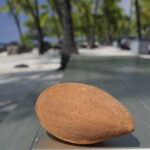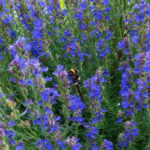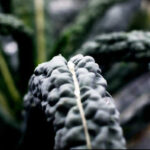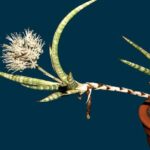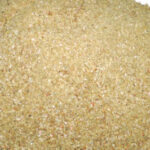I don’t think we could ever live without tubers. Whether it’s the many cooking variations of the potato, the abundant nutrients of the sweet potato, or the rich taste of the yam, these foods are popular for good reason. Today, we’d like to introduce you to one of the world’s favorite, though less heard of, tubers: Dioscorea alata, known as ube or winged yams.
The name makes me imagine a flying Thanksgiving dish, but winged yams are actually used the most in desserts. Their sweet, nutty flavor is similar to a sweet potato or taro. However, these tubers have a smoother texture that makes them perfect for delicate treats.
Perhaps the most notable trait of winged yams is their coloring. Beneath the grubby exterior is surprisingly vibrant purple flesh. You may hear this food go by ‘purple yam plant’ because of its hue. The yams keep their color when cooked, so be prepared to liven up your plate!
Of course, we’re not just here for the food. You’ll find that winged yam plants make a beautiful addition to the garden. Their climbing vines support charming, heart-shaped leaves. And, if you’re lucky, you may get some clusters of yellow-white flowers. So what are you waiting for? Let’s learn all about growing purple yam!
Quick Care Guide
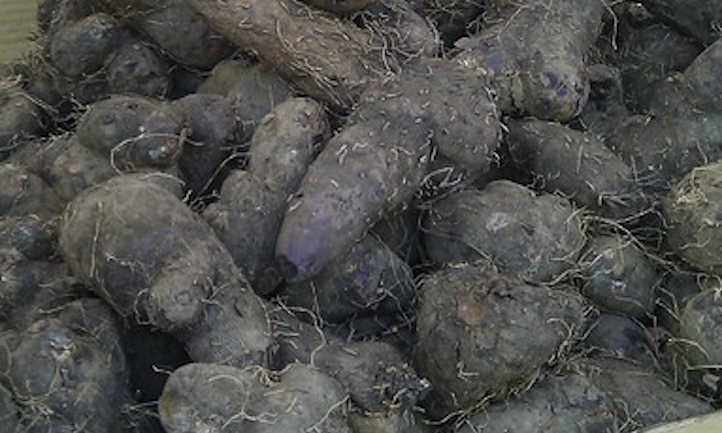
| Common Name(s) | Winged yam, ube, purple yam, greater yam, white yam, water yam |
| Scientific Name | Dioscorea alata |
| Days to Harvest | 6-8 months |
| Light | Full to partial sun |
| Water: | Consistently moist |
| Soil | Loamy, loose, well-draining |
| Fertilizer | Balanced |
| Pests | Root knot nematodes, scale insects |
| Diseases | Anthracnose, mosaic virus |
All About Ube

Before we get started, let’s clear up the yam/sweet potato confusion. Though they look and taste similar, these aren’t the same plants. Sweet potato is actually part of the morning glory family while winged yam is part of the “true yam family”.
Dioscorea alata is grown all around the world, so it has many different names. The common name winged yam comes from the stem’s appearance. It’s square-shaped with flat ridges, or “wings”, lining the corners. You may also hear it called “water yam”, which is referring to the tuber’s high water content. These plants are also referred to as “ube” or “ubi” in Phillippine cuisine.
Winged yam is such an old plant that its exact origin is unknown, though it’s believed to have come from Southeast Asia. Called a cultigen, this species has only been known in cultivation and may even be a hybrid. It came to North America in the 1500s, when it was introduced to Florida by the Spanish and Portugeuse.
Today, ube root crop remains a staple food in Southeast Asia, West Africa, and South America – especially the Philippines. There, it’s used primarily in desserts from cake to ice cream to frappes. Despite its popularity as a dessert-dish, some countries have replaced winged yam with the sweet potato and other crops.
In the US, winged yam has gotten a little out of hand. They’re ruthless plants that will take over any space they find. Winged yam has escaped cultivation in the southern United States, the Virgin Islands, and Puerto Rico. It’s so destructive that the Florida exotic pest plant council has registered it as a fully-fledged invasive species. As gardeners of this plant, we’re responsible for keeping it contained.
It’s not exactly high-maintenance, but growing and containing winged yam is no small feat. The vines have been known to reach 20-30 feet tall, often climbing nearby trees. They grow so quickly that some gardeners have reported 8 inches of growth in a single day.
The vines aren’t the only thing busy growing. Each plant sports one underground tuber. If left unharvested, the tubers will grow and grow until they’ve reached 8 feet long. Sometimes, the vines will grow smaller, aerial tubers above ground (similar to the air potato). These bulbils are meant to develop into new plants and are excellent for propagation.
It may be fast-growing, but these plants aren’t invincible. They only last through the winter in zones 9-11. In colder locations, they must be grown as an annual.
Come harvest time, it’s vital that you make sure you cook the tubers completely before eating as they’re toxic when raw! If any ube tastes bitter, do not eat it. Cooking should render this safe, but the bitterness is a warning sign.
Winged Yam Varieties
In most places, ube is ube. In others though, especially the Philippines, there are many different varieties of this species. Kinampay is considered the original winged yam species. It’s nicknamed “Queen of Philippine Yams” and has 4 further varietes: tamisan, binanag, kabus-ok, and binato.
With these yams, different varieties often mean different colors. While most, such as Zambales, stick to the classic purple, others have varying shades of white. The Basco variety, for example, is white with a lavender tinge. The Leyte variety ranges from a lovely cream color to pink.
Planting

Like potatoes, winged yam is usually grown by planting chunks of the tuber. You can buy the starter pieces online or acquire some from a friend. Small tubers can be planted whole, while large ones can be cut into several pieces. Let the pieces dry out before planting or sprouting them.
In the tropics, Dioscorea alata can be planted any time of year, but usually just after the rainy season. Here in the US, that’s equivalent to spring. Don’t plant your yams in the ground until all chances of frost have passed.
It takes anywhere from 3-12 weeks for the tubers to sprout. You can get ahead of schedule by sprouting the yam pieces before planting. Just stick them in a bucket of soil and keep them moist. Once they sprout, you can transplant them into their permanent homes.
Before planting in the ground, till the soil well. The growing tubers will appreciate the extra room that loose soil gives it. Plant the tubers 4-5 inches deep and 2 feet apart. It’s recommended to add organic mulch on top to hold in water and prevent weeds.
Dioscorea alata can be grown in containers, but you’ll have to watch the size. Use at least a 5-gallon container and harvest the yam before it outgrows its home.
Care
Winged yam species are pretty rough-and-tumble plants. However, you’ll get the best results by following their care preferences. Here’s what we recommend.
Sun and Temperature
Give your winged yam full to partial sunlight. Since it’s from the tropics, it likes to be nice and warm; at least 70°F is preferable. If you live in zones 9-11, you can grow these plants as perennials. Otherwise, the weather will only allow this yam to grow seasonally. Freezing temperatures can cause damage to the roots and green growth.
Water and Humidity
Dioscorea is drought-tolerant, but it thrives best with consistent moisture. Water it whenever the top few inches of the soil begins to dry out. Drip lines or soaker hoses work really well for this plant. When the plants start to die at the end of the growing season, stop watering so they won’t rot.
Humidity isn’t a huge factor here, so long as you keep the soil moist during the summer.
Soil
Dioscorea alata species will grow in a variety of soils. For optimal growth, though, the soil should have all the best features. It should be loamy, fertile, full of organic material, and well-draining. It’s also important that the soil is loose so the tubers can grow easily. A neutral or slightly acidic pH will be fine.
Fertilizing
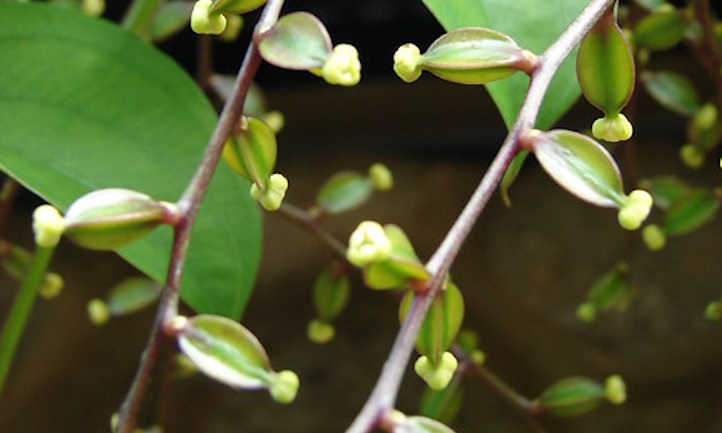
Dioscorea alata isn’t too picky about fertilizer as long as it has nutrients. Stock the soil with organic matter before planting and use mulch. If you’d like to give the plant and aerial tubers an extra boost, apply a balanced fertilizer a couple of times during the growing season.
Pruning and Training
As a climber, this vine will much appreciate a trellis to grow on. Plus, having a support will boost your plant’s growth. When it’s climbing, the vines will spread out and expose more leaf surface for photosynthesis.
Use a trellis, fence, or even a host tree. If the vines don’t take to the support on their own, gently wind them around it. If necessary, tie them loosely with a scrap of fabric. If your plant outgrows its support, prune back the vines with sharp, clean clippers.
If your Dioscorea alata grows aerial tubers that you don’t plan to propagate, clip them off before they mature. This potentially invasive plant spreads quickly through aerial tubers and we want to keep it under control. Destroy the aerial tubers before throwing them out so they don’t take root in your compost bin.
Propagation
It’s rare for Dioscorea to flower in much of the United States, so seed isn’t a common propagation method. Instead, gardeners rely on aerial tubers or root propagation. Start off by cutting the root or aerial tubers from the rest of the plant. Unless you have a very small tuber, cut it into several chunks. Each one is a potential Dioscorea alata.
After they’re cut, you have to let the pieces dry out for a couple days. Otherwise, the new wounds could quickly rot when planted. To speed up the process, dip the cut end in wood ash.
Once dry, bury the pieces in a bucket of dirt and keep it moist. Once they sprout, you can move the baby yams to their permanent home.
Harvesting and Storing

Get your dessert recipes ready, because it’s harvest time! Each plant is one-and-done, so the process shouldn’t take too long.
Harvesting
When the tubers are mature, the foliage will yellow and die. This is your cue to grab the shovel and start harvesting. This usually happens from November to January. If the frost is going to hit your area earlier than that, you’ll want to harvest early.
Carefully pull up the entire plant, using a shovel if necessary. Remove the tubers from the vine and brush off the dirt. It’s that simple!
Ensure that you remove all tubers, aerial tubers, and vines from the ground so nothing is left to its own devices. Otherwise, you may end up with a particularly invasive plant on your hands.
If you live in USDA zones 9-11, you have the option of letting your Dioscorea alata grow for 2 or more years. Just leave it in the ground over winter. It will likely shed its leaves and go dormant for at least a few months. The following harvest season, you should have a massive payoff.
Storing
You can keep your freshly-harvested Dioscorea on the kitchen counter or pantry. It just needs to stay dry or it may sprout. Remember that the tubers are toxic when raw, so you have to cook them completely. It’s also advisable to wear gloves while preparing them.
Cook the Dioscorea alata winged yam as you would a potato. Or, if you have a sweet tooth, head over to Pinterest for some Dioscorea dessert recipes like ube cupcakes. If you have a huge tuber, you can remove a piece at a time, and the remaining winged yam will usually be fine.
For long-term storage, keep your yams in a dry place. Periodically check for and remove any rotted pieces.
Troubleshooting
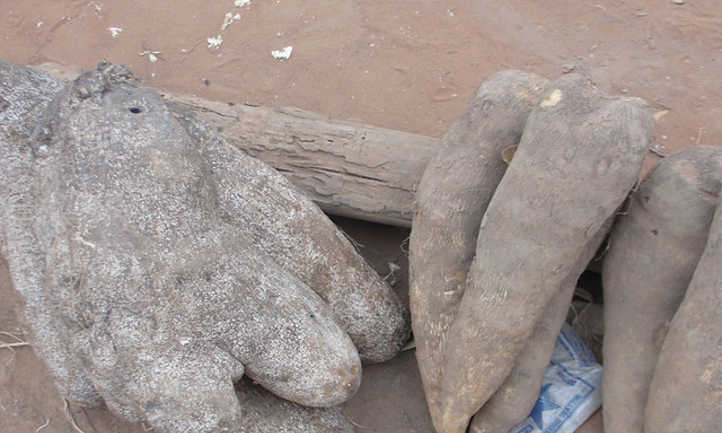
You’re in luck, as there aren’t many problems to deal with when it comes to Dioscorea alata. We’ll go over a few things though, just in case.
Growing Problems
Greening of tubers happens when they’re exposed to sunlight while growing. It’s a result of the tubers producing chlorophyll, the same chemical responsible for photosynthesis in leaves. Depending on the amount, chlorophyll can be dangerous when eaten by humans. Stay on the safe side and discard any green portions.
Prevent this from happening by keeping the tubers covered at all times while they’re growing. If at any time the tubers poke out of the soil, quickly make a mound over it.
Pests
Root-knot nematodes hit this species right where it hurts: the tuber. They’ll disrupt their growth and cause knots and deformities. Above-ground, you’ll notice stunted growth and yellowing leaves. Prevent these nematodes by tilling the soil well before and after each harvest. You should also use crop rotation with nematode-resistant plants. For existing infestations, try a nematicide. Geraniol and quillaja saponaria based treatments are a good organic option. Alternately, add beneficial nematodes to the soil as they will hunt down and kill the root-knot nematodes.
Scale insects, particularly white scales and mealybugs, are common pests that feed on Dioscorea alata juice. They secrete honeydew that attracts ants, which is another pest to eliminate. The best approach is to prevent these insects in the first place. Keeping the soil clear of debris and the plant dry are the best measures. You can also prune infested vines or remove the pests one by one with a dab of rubbing alcohol. For large infestations, try using an insecticidal soap, or beneficial predators such as lacewings or ladybugs. Neem oil or horticultural oil can kill off their eggs.
Diseases
Anthracnose is a fungal disease that will cause leaf spots on your beautiful Dioscorea alata species. In time, it can yellow and wither the leaves, eventually killing them. This disease usually isn’t fatal to the whole plant, but can definitely affect its growth. Try a dose of neem oil, copper fungicide, or sulfur dust fungicide to treat this fungus. Prevent anthracnose by keeping your plant clean and dry.
The mosaic virus creates a “mosaic” of color on the leaves, usually in shades of yellow and green. It sounds pretty, but the coloring is caused by damage to the veins, which are vital to the plant’s health. This disease will stunt Dioscorea alata’s growth and even affect the starch content of the tuber.
This virus is typically transmitted by Dioscorea alata cuttings, so ensure that you’re only planting disease-free yams. Insects can also transmit the disease, so arm yourself against any pest problems. There’s no cure for this disease, so prevention is your only weapon.
Frequently Asked Questions
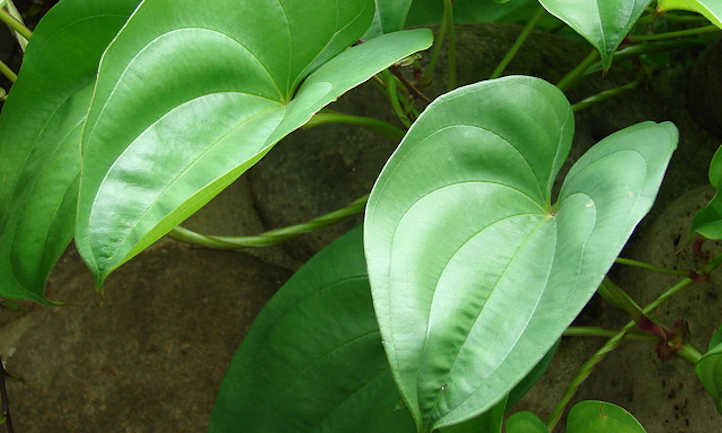
Q: Is purple yam poisonous?
A: It can be, but only if eaten raw. Avoid this by cooking your Dioscorea alata completely before consuming.
Q: Are purple yam leaves edible?
A: Dioscorea is often confused with sweet potato, which does have edible leaves. We do not recommend you eat the leaves of Dioscorea alata. While some yams do have leaves that are safe once cooked, this one is still a little too risky.
Q: Is taro and yam the same thing?
A: No, but they’re close! The tubers look and taste similar, but taro species lacks the smooth texture and vibrant coloring of Dioscorea alata winged yam. The plants look completely unrelated, given that taro is bushy with large leaves while winged yam is a vine.



